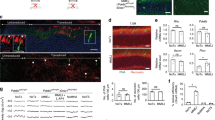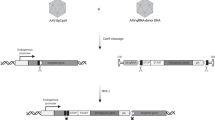Abstract
Recombinant adeno-associated virus (rAAV) has become an important gene delivery vector for the treatment of inherited retinal degenerative diseases. Many of the mutations leading to retinal degeneration are inherited in an autosomal-dominant pattern and can produce toxic gain-of-function and/or dominant-negative effects. Here we describe an allele-independent gene therapy strategy with rAAV to treat autosomal-dominant retinal degenerative diseases. In this methodology, we co-deliver a short-hairpin RNA (shRNA) to inhibit expression of both the toxic and (WT) copies of the gene as well as an shRNA-resistant cDNA for functional gene replacement with a rAAV.
Access this chapter
Tax calculation will be finalised at checkout
Purchases are for personal use only
Similar content being viewed by others
References
RetNet: Summaries. https://sph.uth.edu/Retnet/sum-dis.htm. Accessed 26 Oct 2017
Maguire AM, Simonelli F, Pierce EA et al (2008) Safety and efficacy of gene transfer for Leber’s congenital amaurosis. N Engl J Med 358:2240–2248. https://doi.org/10.1056/NEJMoa0802315
Hauswirth WW, Aleman TS, Kaushal S et al (2008) Treatment of Leber congenital amaurosis due to RPE65 mutations by ocular subretinal injection of adeno-associated virus gene vector: short-term results of a phase I trial. Hum Gene Ther 19:979–990. https://doi.org/10.1089/hum.2008.107
Jacobson SG, Cideciyan AV, Ratnakaram R et al (2012) Gene therapy for Leber congenital amaurosis caused by RPE65 mutations: safety and efficacy in 15 children and adults followed up to 3 years. Arch Ophthalmol 130:9–24. https://doi.org/10.1001/archophthalmol.2011.298
OMIM Entry - * 180380 - RHODOPSIN; RHO. http://www.omim.org/entry/180380. Accessed 26 Oct 2017
OMIM Entry - # 153700 - MACULAR DYSTROPHY, VITELLIFORM, 2; VMD2. http://www.omim.org/entry/153700#genotypePhenotypeCorrelations. Accessed 26 Oct 2017
Zeng Y, Wagner EJ, Cullen BR (2002) Both natural and designed micro RNAs can inhibit the expression of cognate mRNAs when expressed in human cells. Mol Cell 9:1327–1333. https://doi.org/10.1016/S1097-2765(02)00541-5
Carthew RW, Sontheimer EJ (2009) Origins and mechanisms of miRNAs and siRNAs. Cell 136:642–655. https://doi.org/10.1016/j.cell.2009.01.035
Pratt AJ, MacRae IJ (2009) The RNA-induced silencing complex: a versatile gene-silencing machine. J Biol Chem 284:17897–17901. https://doi.org/10.1074/jbc.R900012200
Fakhr E, Zare F, Teimoori-Toolabi L (2016) Precise and efficient siRNA design: a key point in competent gene silencing. Cancer Gene Ther 23:73–82. https://doi.org/10.1038/cgt.2016.4
Li C, Xiao P, Gray SJ et al (2011) Combination therapy utilizing shRNA knockdown and an optimized resistant transgene for rescue of diseases caused by misfolded proteins. Proc Natl Acad Sci U S A 108:14258–14263. https://doi.org/10.1073/pnas.1109522108
Millington-Ward S, Chadderton N, O’Reilly M et al (2011) Suppression and replacement gene therapy for autosomal dominant disease in a murine model of dominant retinitis pigmentosa. Mol Ther 19:642–649. https://doi.org/10.1038/mt.2010.293
Mueller C, Tang Q, Gruntman A et al (2012) Sustained miRNA-mediated knockdown of mutant AAT with simultaneous augmentation of wild-type AAT has minimal effect on global liver miRNA profiles. Mol Ther 20:590–600. https://doi.org/10.1038/mt.2011.292
Mao H, Gorbatyuk MS, Rossmiller B et al (2012) Long-term rescue of retinal structure and function by rhodopsin RNA replacement with a single adeno-associated viral vector in P23H RHO transgenic mice. Hum Gene Ther 23:356–366. https://doi.org/10.1089/hum.2011.213
O’Reilly M, Palfi A, Chadderton N et al (2007) RNA interference–mediated suppression and replacement of human rhodopsin in vivo. Am J Hum Genet 81:127–135. https://doi.org/10.1086/519025
Baer M, Nilsen TW, Costigan C, Altman S (1990) Structure and transcription of a human gene for H1 RNA, the RNA component of human RNase P. Nucleic Acids Res 18(1):97
Brummelkamp TR, Bernards R, Agami R (2002) A system for stable expression of short interfering RNAs in mammalian cells. Science 296:550–553. https://doi.org/10.1126/science.1068999
Ma H, Wu Y, Dang Y et al (2014) Pol III promoters to express small RNAs: delineation of transcription initiation. Mol Ther Nucleic Acids 3:e161. https://doi.org/10.1038/mtna.2014.12
Gao Z, Harwig A, Berkhout B et al (2017) Mutation of nucleotides around the +1 position of type 3 polymerase III promoters: The effect on transcriptional activity and start site usage. Transcription 8(5):275–287. https://doi.org/10.1080/21541264.2017.1322170
Schneider CA, Rasband WS, Eliceiri KW (2012) NIH Image to ImageJ: 25 years of image analysis. Nat Methods 9:671–675. https://doi.org/10.1038/nmeth.2089
Grote A, Hiller K, Scheer M et al (2005) JCat: a novel tool to adapt codon usage of a target gene to its potential expression host. Nucleic Acids Res 33:W526–W531. https://doi.org/10.1093/nar/gki376
Wang XS, Ponnazhagan S, Srivastava A (1996) Rescue and replication of adeno-associated virus type 2 as well as vector DNA sequences from recombinant plasmids containing deletions in the viral inverted terminal repeats: selective encapsidation of viral genomes in progeny virions. J Virol 70:1668–1677
Zhou Q, Tian W, Liu C et al (2017) Deletion of the B-B’ and C-C’ regions of inverted terminal repeats reduces rAAV productivity but increases transgene expression. Sci Rep 7(1):5432. https://doi.org/10.1038/s41598-017-04054-4
Biswal MR, Han P, Zhu P et al (2017) Timing of antioxidant gene therapy: implications for treating dry AMD. Invest Ophthalmol Vis Sci 58:1237–1245. https://doi.org/10.1167/iovs.16-21272
Guy J, Qi X, Koilkonda RD et al (2009) Efficiency and safety of AAV-mediated gene delivery of the human ND4 complex I subunit in the mouse visual system. Invest Ophthalmol Vis Sci 50:4205–4214. https://doi.org/10.1167/iovs.08-3214
Boye SE, Alexander JJ, Boye SL et al (2012) The human rhodopsin kinase promoter in an AAV5 vector confers rod- and cone-specific expression in the primate retina. Hum Gene Ther 23:1101–1115. https://doi.org/10.1089/hum.2012.125
Yang GS, Schmidt M, Yan Z et al (2002) Virus-mediated transduction of murine retina with adeno-associated virus: effects of viral capsid and genome size. J Virol 76:7651–7660. https://doi.org/10.1128/JVI.76.15.7651-7660.2002
Allocca M, Mussolino C, Garcia-Hoyos M et al (2007) Novel adeno-associated virus serotypes efficiently transduce murine photoreceptors. J Virol 81:11372–11380. https://doi.org/10.1128/JVI.01327-07
Lebherz C, Maguire A, Tang W et al (2008) Novel AAV serotypes for improved ocular gene transfer. J Gene Med 10:375–382. https://doi.org/10.1002/jgm.1126
Scalabrino ML, Boye SL, Fransen KMH et al (2015) Intravitreal delivery of a novel AAV vector targets ON bipolar cells and restores visual function in a mouse model of complete congenital stationary night blindness. Hum Mol Genet 24:6229–6239. https://doi.org/10.1093/hmg/ddv341
Kay CN, Ryals RC, Aslanidi GV et al (2013) Targeting photoreceptors via intravitreal delivery using novel, capsid-mutated AAV vectors. PLoS One 8(4):e62097. https://doi.org/10.1371/journal.pone.0062097
Dalkara D, Byrne LC, Klimczak RR et al (2013) In vivo–directed evolution of a new adeno-associated virus for therapeutic outer retinal gene delivery from the vitreous. Sci Transl Med 5:189ra76–189ra76. https://doi.org/10.1126/scitranslmed.3005708
Vector production options. http://ogtc.eye.ufl.edu/2016/04/20/vector-production-options/. Accessed 16 Nov 2017
Song H, Yang P-C (2010) Construction of shRNA lentiviral vector. North Am J Med Sci 2:598–601. https://doi.org/10.4297/najms.2010.2598
Mello CC, Conte D (2004) Revealing the world of RNA interference. Nature 431:338–342. https://doi.org/10.1038/nature02872
Cideciyan AV, Sudharsan R, Dufour VL, Massengill MT, Iwabe S, Swider M, Lisi B et al (2018) Mutation-independent rhodopsin gene therapy by knockdown and replacement with a single AAV vector. Proc Natl Acad Sci 115(36):E8547. https://doi.org/10.1073/pnas.1805055115
Acknowledgments
This work was funded by an F30 from the NEI (MM), an R01 from the NEI (ASL), a grant from the Bright Focus Foundation (CJI) and an unrestricted grant from the Research to Prevent Blindness (CJI).
Author information
Authors and Affiliations
Corresponding author
Editor information
Editors and Affiliations
Rights and permissions
Copyright information
© 2019 Springer Science+Business Media, LLC, part of Springer Nature
About this protocol
Cite this protocol
Massengill, M.T., Young, B.M., Lewin, A.S., Ildefonso, C.J. (2019). Co-Delivery of a Short-Hairpin RNA and a shRNA-Resistant Replacement Gene with Adeno-Associated Virus: An Allele-Independent Strategy for Autosomal-Dominant Retinal Disorders. In: Manfredsson, F., Benskey, M. (eds) Viral Vectors for Gene Therapy. Methods in Molecular Biology, vol 1937. Humana Press, New York, NY. https://doi.org/10.1007/978-1-4939-9065-8_15
Download citation
DOI: https://doi.org/10.1007/978-1-4939-9065-8_15
Published:
Publisher Name: Humana Press, New York, NY
Print ISBN: 978-1-4939-9064-1
Online ISBN: 978-1-4939-9065-8
eBook Packages: Springer Protocols




